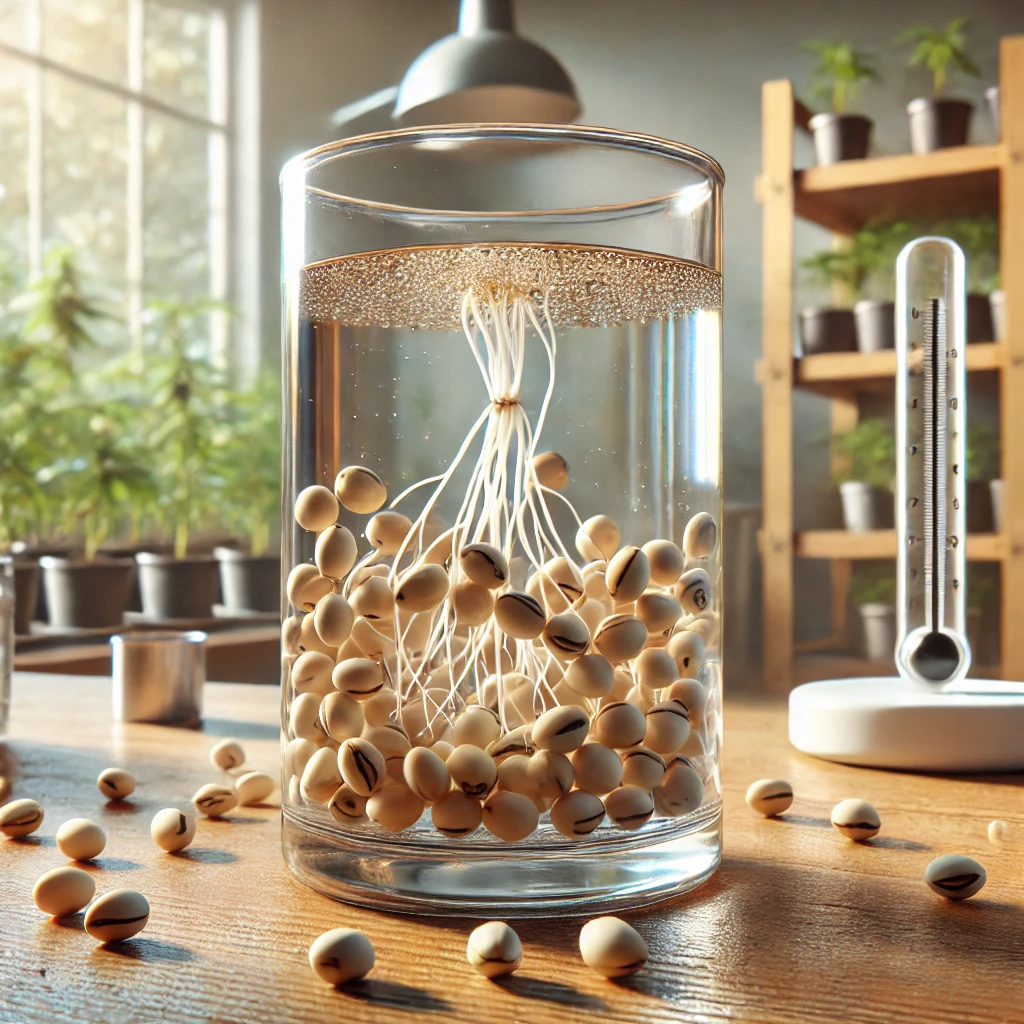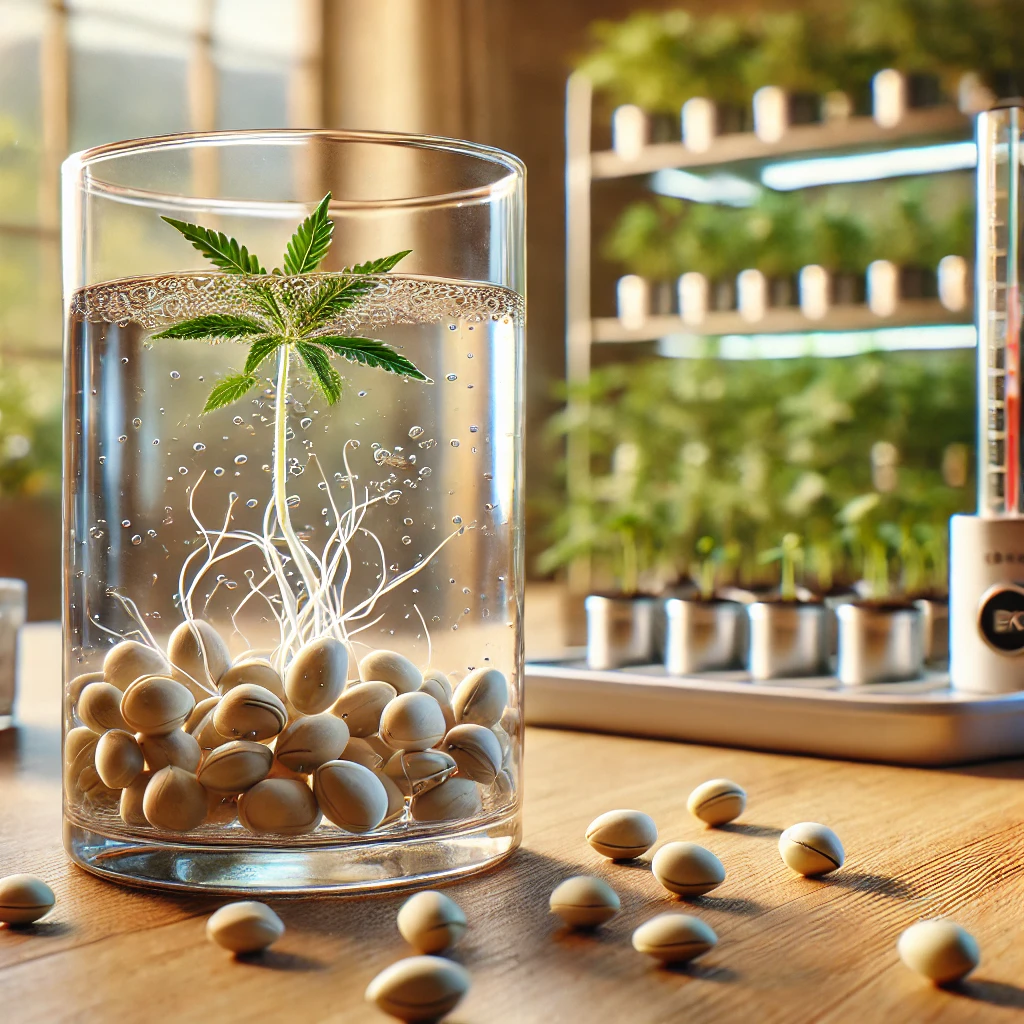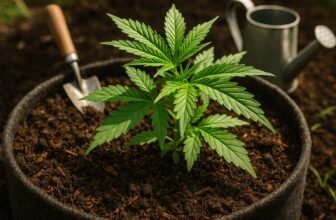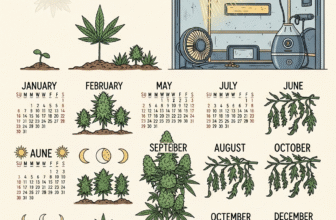
Germinating weed seeds is the very first step in growing healthy cannabis plants, and one of the easiest ways to start is by using the water germination method. This simple technique involves soaking your cannabis seeds in water for a short period to encourage the taproot to emerge, which is a sign that your seed is ready to be planted. It’s a method favored by beginners and experienced growers alike because it requires minimal supplies and gives quick visual feedback on seed viability.
In this guide, you’ll learn exactly how to germinate weed seeds in water step by step, what signs to look for, how long it typically takes, and how to avoid common mistakes like over-soaking or using poor-quality water. Whether you’re prepping for an indoor grow or getting ready for an outdoor garden, this method can boost your success rate and help you start strong. Let’s dive in and explore how this beginner-friendly germination technique works.
What Is the Water Germination Method?
The water germination method is a simple and effective way to start cannabis seeds by soaking them in water to trigger sprouting. This technique is especially popular among beginner growers because it allows for easy monitoring of the seed’s progress and doesn’t require any special equipment. When you soak cannabis seeds in clean, room-temperature water, the seed’s protective shell begins to soften, allowing moisture to activate the embryo inside. Within 12 to 48 hours, most healthy seeds will begin to show a small white root tip known as a taproot, marking the start of the germination process.
This method is part of a broader category of cannabis seed germination techniques, but it stands out for its simplicity and speed. It’s particularly useful when testing seed viability—if a seed sinks, it’s generally considered viable; if it floats for more than 24 hours, it may be weak or dead. By observing the seed sprouting directly in water, growers can easily determine which seeds are worth planting. Additionally, the water germination method sets the stage for a healthy taproot development, which is crucial for strong seedling growth and future root stability.
Using this technique as part of your germination routine also allows for quick transfer to a growing medium, such as soil or coco coir, once the taproot emerges. When done correctly, the water method can significantly improve your cannabis seedling success rate, especially if paired with optimal conditions like stable temperatures and pH-balanced water.

Supplies You Need to Germinate Weed Seeds in Water
To successfully germinate weed seeds in water, you’ll only need a few basic supplies—most of which are readily available at home. The most important items are a clean glass or cup and purified or distilled water. Using high-quality water is essential to prevent harmful chemicals like chlorine or heavy metals from interfering with seed germination. Tap water can sometimes reduce cannabis seed viability, especially in delicate or older seeds, so always opt for clean, pH-balanced water when possible.
You’ll also want to ensure that the water temperature for germination is within the ideal range of 20–25°C (68–77°F). Water that’s too cold may slow down or stall the germination process, while overly warm water can damage the seed. A dark, warm place like a cupboard or closet can help maintain the right environment while your seeds are soaking. Many growers place a plate over the glass to block out light and keep temperatures stable during the soaking phase.
While not mandatory, having starter trays or a seedling mat ready for post-germination can make the transition from water to soil smoother. Once the taproot development begins and the seed sprouts, you’ll need to transfer it carefully to your preferred growing medium—whether that’s soil, coco coir, or a hydroponic setup. Keeping these supplies ready ensures you don’t delay the transfer, which is crucial to protect the fragile root and maximize your cannabis seedling success rate.
Step-by-Step Instructions: Germinate weed seeds in water
Germinating weed seeds in water is a beginner-friendly process, but timing and care are essential to ensure success. Follow these steps to give your cannabis seeds the best start in life:
Step 1 – Prepare Clean Water and Container
Start by filling a clean glass or cup with purified or distilled water. Avoid tap water if possible, as it may contain chlorine or minerals that affect seed germination. Make sure the water temperature is between 20–25°C (68–77°F), which supports optimal taproot development. Too cold, and the seed might remain dormant; too warm, and it may rot.

Step 2 – Drop Seeds into the Water
Gently place your cannabis seeds into the glass. Some will float, and others will sink. This is normal. In fact, observing floating seeds vs sinking seeds can give you a rough idea of seed quality—sinking seeds are often more viable, though floating seeds can still germinate. You don’t need to force them down; just let them soak naturally.

Step 3 – Soak for 12 to 48 Hours
Leave the seeds in the water for 12 to 48 hours in a dark, warm environment. Many growers cover the cup with a plate or foil to simulate darkness, which mimics natural soil conditions and encourages the seed to crack open. During this phase, cannabis seed sprouting begins, and a small white taproot will emerge. Once this root appears—typically within 24 to 36 hours—the seed is ready for planting.

Throughout this process, avoid agitating the water or handling the seeds too often. If the taproot grows longer than ½ inch, it’s best to transfer the seed immediately to prevent breakage. Successfully following these steps will significantly improve your cannabis seedling success rate, setting the foundation for healthy plant growth.

When to Remove Seeds from Water
Knowing the right time to remove your seeds from water is crucial for successful cannabis seed germination. Typically, after 12 to 48 hours of soaking, healthy seeds will begin to crack open and show a small white tail—this is the taproot. As soon as you see this sign of taproot development, it’s time to carefully transfer the seed to your chosen growing medium. Leaving seeds in water too long can increase the risk of rot, mold, or oxygen deprivation, all of which can reduce your cannabis seedling success rate.
The ideal window is when the taproot is just emerging, about ¼ to ½ inch long. At this point, the seed has absorbed enough moisture to trigger internal activity but hasn’t become waterlogged. If you wait too long, the seed may swell excessively or begin to decay, especially if the water temperature for germination is too warm or stagnant. Make sure to handle the seed gently—hold it by the shell and avoid touching the fragile taproot to prevent transplant shock or contamination.
If a seed hasn’t sprouted after 48 hours in water, you can transfer it to the paper towel method for further germination or discard it if it’s clearly non-viable. Monitoring your seeds during this window will ensure you catch that critical moment when cannabis seed sprouting is underway, giving you the best chance of strong, healthy seedlings.
What to Do After Germination
Once your cannabis seeds have successfully sprouted in water and you see a healthy white taproot emerging, it’s time to plant them into a growing medium. This next step is critical to maintaining strong taproot development and ensuring your seedlings have the right conditions to thrive. Gently remove the seed from the water using sanitized tweezers or your clean fingers—always handle the seed by the shell and avoid touching the delicate root, as it can be easily damaged.
The most common mediums for transplanting germinated seeds include soil, coco coir, or starter plugs like Rockwool or peat pellets. Make a small hole about ½ inch deep and place the seed with the taproot facing down, then lightly cover it with soil. This helps the sprout naturally orient itself and push upward toward the light. For best results, maintain high humidity, stable temperatures (70–80°F or 21–27°C), and gentle lighting. These conditions support cannabis seedling success rate and reduce the risk of transplant shock.
If you’re using a hydroponic system, such as a soilless growing medium, make sure the sprouted seed is placed into a moist and oxygen-rich environment where the root can grow freely. Whether you’re growing in soil or hydro, early care is essential for healthy cannabis seed sprouting. Keep the medium slightly moist but not soggy—overwatering can suffocate young roots. By properly transitioning your germinated seeds after the water germination method, you’ll set the foundation for vigorous cannabis growth from seedling to harvest.
Pros and Cons of Water Germination
The water germination method is one of the easiest and fastest ways to start cannabis seeds, but like any technique, it comes with both advantages and drawbacks. Understanding these pros and cons can help you decide whether it’s the right approach for your grow setup and experience level.
Overall, the water germination method is an efficient way to kickstart your cannabis grow—especially when executed with care and close observation. It’s ideal for viable, fresh seeds and growers who want a quick, visual confirmation of germination success.
Common Mistakes and How to Avoid Them
Even though the water germination method is beginner-friendly, several common mistakes can reduce your chances of successful cannabis seed germination. Avoiding these pitfalls is essential to maintaining healthy taproot development and ensuring a strong start for your plants.
❌ Soaking Seeds for Too Long
One of the biggest mistakes is over-soaking cannabis seeds—leaving them in water for more than 48 hours. While a 12 to 36-hour window is ideal for most seeds, extended soaking can deprive the seed of oxygen, leading to rot or fungal issues. To avoid this, monitor your seeds closely and transfer them to your growing medium as soon as the taproot appears.
❌ Using Poor-Quality Water
Tap water that contains chlorine or heavy metals can negatively affect seed viability. Always use purified or distilled water with a balanced pH to promote successful cannabis seed sprouting. The water temperature for germination should also be warm (around 20–25°C or 68–77°F), as cold water can delay or halt the germination process.
❌ Handling the Taproot Incorrectly
Once the taproot emerges, it becomes incredibly delicate. Touching it with bare hands or applying too much pressure during the transfer can cause transplant shock or root damage. To avoid this, use sanitized tweezers or carefully handle the seed by its shell only.
❌ Ignoring Environmental Conditions Post-Germination
Many growers forget that germination is just the beginning. After the seed is moved from water to soil or a soilless growing medium, the environment must be kept warm, humid, and gently lit to support ongoing root growth and seedling success. Skipping this step can lead to stalled growth or cannabis seedling failure.
Water Germination vs Other Methods
While the water germination method is a fast and beginner-friendly way to start your cannabis seeds, it’s just one of several popular seed germination techniques used by growers. Each method has its own advantages and limitations, depending on your grow setup, experience level, and seed quality. Let’s compare water germination with a few other commonly used methods to help you decide what works best for your situation.
🌱 Water Germination
This method involves soaking cannabis seeds in water for 12 to 48 hours to trigger taproot development. It’s ideal for growers who want quick visual confirmation of cannabis seed sprouting and prefer minimal tools. However, it carries a slight risk of over-soaking, which can harm seed viability or lead to rot if the water temperature for germination isn’t stable.
🌱 Paper Towel Method
A widely used method where seeds are placed between moist paper towels and kept in a warm, dark space. It allows for controlled moisture and easy monitoring of taproot growth. Compared to water germination, the paper towel method gives seeds slightly more oxygen, reducing the chance of rot—but it also requires careful handling and regular moisture checks.
🌱 Direct-to-Soil Germination
This approach skips the soaking step altogether by planting seeds directly into a moist growing medium such as soil or coco coir. It’s more natural and reduces transplant stress, but you can’t monitor seed viability or progress as easily. This method works well for experienced growers who understand how to maintain optimal moisture, temperature, and humidity.
🌱 Rapid Rooters & Soilless Plugs
These ready-made starter cubes (made of peat or foam) offer a clean and controlled environment for cannabis seed germination. They retain moisture well and are especially useful in hydroponic or soilless growing mediums. However, they can be more expensive and aren’t always necessary for small-scale or budget-conscious growers.
🧪 Which Method Is Best for You?
If you’re just getting started, germinating weed seeds in water is a great way to quickly evaluate seed health and observe taproot development in real-time. But for long-term consistency and reduced risk of mistakes, combining water germination with the paper towel method or transitioning quickly to starter plugs may yield better overall results. Choose the method that aligns with your growing goals, setup, and comfort level—what matters most is creating the right conditions for your seedlings to thrive.
FAQs
You should soak your cannabis seeds in water for 12 to 48 hours. Most healthy seeds will begin to show a taproot within this time frame. If you don’t see any signs of cannabis seed sprouting after 48 hours, consider transferring them to the paper towel method to continue germination. Avoid soaking for longer than 48 hours to prevent rot or oxygen deprivation.
It’s common for weed seeds to float when first placed in water. Over time, viable seeds often sink as they absorb moisture. However, floating seeds aren’t always non-viable—some healthy seeds float but still sprout later. You can gently tap them to see if they sink, but don’t force them. Instead, focus on whether taproot development begins within 48 hours.
Yes, the water germination method works for autoflower cannabis seeds just like it does for photoperiod strains. Just be cautious with timing, as autoflower seeds have a limited vegetative window. Ensure a quick transition from water to soil or another growing medium once the taproot emerges, so the plant’s growth cycle isn’t delayed.
Absolutely. Hydroponic growers often use water germination followed by transferring the seed to soilless growing mediums like Rockwool, clay pellets, or coco coir. Just make sure the seedling environment stays warm, moist, and well-oxygenated to support successful root establishment in hydro systems.
No, light is not necessary during the soaking phase. Seeds germinate best in a dark, warm environment—just like they would underground. Cover the glass or place it in a cupboard to mimic natural conditions and protect developing seeds from stress.
Conclusion
Germinating weed seeds in water is a fast, simple, and effective way to start your cannabis grow. By following the correct steps—using clean, warm water, monitoring seed progress closely, and transferring them at the right time—you can significantly boost your cannabis seedling success rate. This method is especially helpful for beginners who want to see early signs of taproot development without investing in advanced tools or growing setups.
While it’s not the only method available, water germination offers clear benefits: it’s easy to execute, helps verify seed viability, and gives you quick feedback. As long as you avoid common mistakes like over-soaking or mishandling the sprout, this technique can give your cannabis plants a healthy head start. Whether you’re growing photoperiod or autoflower strains, this germination method is a valuable tool in your cultivation journey.
Once your seeds are germinated and ready to plant, you can choose to grow them indoors or out. For those considering an outdoor setup, growing weed outdoors can be highly rewarding—thanks to natural sunlight, larger plant sizes, and lower energy costs. If you’re interested in taking your germinated seeds straight into nature, check out our complete guide on growing weed outdoors for tips on soil preparation, pest control, and maximizing yields in open-air environments.






